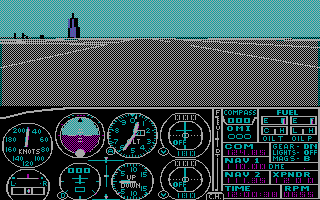As a frequent flier I was always curious about the functional aspect of airplanes. Flight dynamics aside, the operational aspect of an aircraft has always been a mystery. How do you operate a heavy piece of equipment in a 3D space? How do pilots bring down an aircraft with such precision? What exactly is auto-pilot, and how does this technology enable auto landing with minimum human input and nearly no visibility? How do pilots communicate with Air Traffic Control? Would handling an aircraft be as straight forward as driving a car?

MS Flight Simulator II – the program which began my flight simulation fascination
In my youth I was exposed to Microsoft Flight Simulator II – the images of Meigs Field Chicago are still fresh in my mind. Years later, having grown up in the PC era, I awed at Flight Unlimited and its beautiful graphics (ahead of it’s time) when it was first released in 1995, but I would say this hobby (obsession) only began when I managed to obtain a copy of Flight Simulator X and the PMDG 737NG in 2010. It came to my realisation the computer could be used as a great aviation learning tool. Here, for the first time, was a piece of software with accurate systems modelling and it was possible to practice procedures in real time. The simulator aircraft could be used as a study resource. I would use the simulator using simple control inputs – first with the mouse and keyboard, and then slowly upgrading to a yoke, rudder pedals and tactile push buttons. I progressed by learning the basic systems of the aircraft, ATC phraseology and even flying online on Vatsim (a network with human virtual pilots and controllers) with the goal of practicing realistic procedures. All of this was unique because it was possible for anyone with aviation interest to train in a home desktop environment.
There was a yearning to bring more realism to the virtual flying. For many months I observed a small and growing community on MyCockpit. I watched in great interest a cockpit building Google Story. It was possible after all to build your own realistically sized cockpit — many others around the world had done so. I started out with the Boeing 737 and Prosim 737, as this was the most popular, and I was familiar with the systems from my time with the PMDG. The Boeing 747 and Aerowinx software was also seriously considered. However, in the end I decided to move over to the Airbus, the modern systems were appealing, and from a building perspective more straight forward to implement because of the fly-by-wire controls. FMGS, a freely available airbus avionics suite also help to steer me to this decision.
Today the cockpit building continues in a small wintergarden in an apartment in Sydney. It brings immense satisfaction when avionics equipment from retired aircraft are brought to life again by interfacing with the flight simulator. Along the way I have met experienced simulator builders, engineers, real world pilots and have built many lasting friendships all around the world. This blog is about this journey. Welcome aboard!
Ben
Soarbywire
Sydney, February 2017

AirAsia X A330 Sydney – Kuala Lumpur (May 2015)
** Ben is an Occupational Medicine Practitioner in Sydney, Australia. He is a CASA Designated Aviation Medical Examiner (DAME).